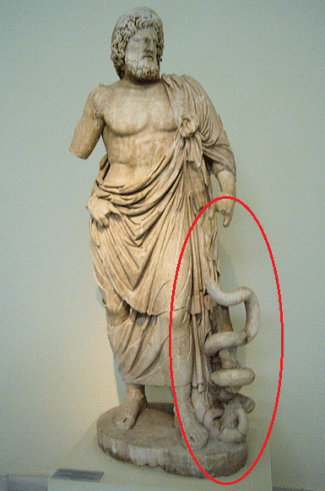2 Now there is in Jerusalem by the Sheep Gate a pool, in Hebrew called Bethesda, which has five roofed colonnades. 3 In these lay a multitude of invalids—blind, lame, and paralyzed.[1] 5One man was there who had been an invalid for thirty-eight years.
When it comes to determining the level of the gospel’s historical reliability, the story that will end in the healing of a paralyzed man is one of the most fascinating textual units in the Gospel of John. Until the discovery of the pool with five-roofed colonnades near the Sheep Gate, many did not consider the Gospel of John to be historically reliable. The gospel was thought to be either allegorical (truthful only in the sense similar to apocalyptic literature) or simply inaccurate (written by someone who was not from Judea and wholly unfamiliar with Jerusalem’s geography). However, thanks to the tireless research of archeologists, both pools mentioned in the Gospel of John were identified – the Pool of Bethesda in John 5.2 (Image courtesy of Carta Jerusalem) and the Pool of Siloam in John 9.7. The pool mentioned in this chapter turned out to have five colonnades (as described in the Gospel), but it was not structured as a pentagon. There were four colonnades separated in the middle by another one; thus forming the five colonnades.
It is possible that that these pools were religious ceremonial water cleansing facilities – mikvaot, associated with the Jerusalem Temple; or simply water reservoirs for general civic consumption (at least in some periods of their use). But there are other interpretive options as well.
Some archaeologists who worked with this discovery for many years, found and excavated several snake figures at that pool; indicating that the area may have housed a Jerusalem branch of Asclepius cult. While we must be careful not to asume that we can know these things with certainty (for example, none of the artfacts connected to Asclepeus that were found at the site were dated to the first century), some interesting ideas are still worth considering. So having given some space to disclaimers, who was Asclepius?
 Asclepius was the god of medicine and healing in ancient Greek religion. The god’s mythical daughters included the goddesses Hygeia and Panacea. We can hear in their Greek names our modern words for “hygiene” and “panacea” – key concepts associated today with medicine and health. Snakes of course were a key attribute of Asclepius’s cult of health and healing (see circled area on the image of Aclepeus). Up until today one of the key symbols of modern medicine is a stick with a snake around it.
Asclepius was the god of medicine and healing in ancient Greek religion. The god’s mythical daughters included the goddesses Hygeia and Panacea. We can hear in their Greek names our modern words for “hygiene” and “panacea” – key concepts associated today with medicine and health. Snakes of course were a key attribute of Asclepius’s cult of health and healing (see circled area on the image of Aclepeus). Up until today one of the key symbols of modern medicine is a stick with a snake around it.
Now stop and think for a moment. Because, if this is correct, it may change our perception of the entire story described here. You see it is possible that the blind, lame, and paralyzed were not waiting for Israel’s god to heal them; but rather for the merciful healing act of Asclepius. In that case, the pool of Bethesda (house of mercy in Hebrew) does not have to be a Jewish si te at all, but rather a Greek Asclepion-affiliated facility. This of course would be consistent with a thoroughly Hellenized Jerusalem and Judea in the time of Jesus. We already know that this is the case from many historical and archeological studies.
te at all, but rather a Greek Asclepion-affiliated facility. This of course would be consistent with a thoroughly Hellenized Jerusalem and Judea in the time of Jesus. We already know that this is the case from many historical and archeological studies.
It is very important to notice that in this particular healing Jesus does not command the one he healed to wash himself in the pool (pool of Bethhesda), while he does issue a direct command to go and wash at the pool of Siloam when it comes to the healing of the blind man (John 9.6-7). It therefore appears that while the pool of Bethehesda was a pagan place, the pool of Siloam was not. Of course, Jerusalem was the center for religious Jews in Jesus’ days, but it was also a headquarters for Hellenized ideals in Judea that was under strict Roman control with the Antonia Fortress dominating the northwestern end of the Temple Mount.
Therefore, as the author of the Gospel continues to show Jesus as the incarnated divine Logos/Memra of Israel’s God, we see the real tension of the story: Who has the power to heal, the Greek god Asclepius, or the Judean god, through his royal son Jesus?[2]
We will see more of this interesting polemic as we continue our fascinating study.
To receive more information about learning Biblical Languages with Hebrew University of Jerusalem/eTeacher Biblical program online at affordable cost, please, click here.
© By Eli Lizorkin-Eyzenberg, Ph.D.
To sign up for weekly posts by Dr. Eli, please, click here. It is recommend by Dr. Eli that you read everything from the begining in his study of John. You can do so by clicking here – “Samaritan-Jewish Commentary”.
[1] Some manuscripts insert, wholly or in part, “waiting for the moving of the water; 4for an angel of the Lord went down at certain seasons into the pool, and stirred the water: whoever stepped in first after the stirring of the water was healed of whatever disease he had.”
[2] This is very similar to the kind of ancient cross-religious polemics described in the healing of Naaman (2 Kings 5). In the minds of the ancients, rivers were conceived of as channels of blessings that came directly from the country’s particular gods. Will the rivers of Israel be better than the rivers of Aram? (2 Kings 5.12) Will the God of Israel win the god of Aram?








I rejoice in the new knowledge revealed through this study!
It is so exciting to know that there is always more to learn from scripture that we think we know well.
My daughters asked me why a symbol of a snake is used to represent medical institutions etc. and my response was based on the fact that God instructed Moses to make and lift up the bronze serpent and set it on a pole in the wilderness (closely resembling the medical symbol we know today), as a symbol of healing for those who had suffered snakebites.
Is this association true or would it rather be the symbol of snakes associated with Asclepius’ cult of health and healing that relates to the modern use of this symbol?
P.S. I am very blessed to be a part of your study group Dr. Eli 🙂
Dear Madeli, shalom. I think our modern symbols do come from the Greek cult of Asclepius and not from Moses. Thank you for your kind words about my studies. May the Lord richly bless you and keep you. Dr. Eli
I read through the article and many of the comments. it all seems a rather plausible conclusion.
However i notice one point that i dont necessarily agree with. that point is, why is it a competition between the gods of men vs the god of israel?
hear me for a moment. in other cases, yeshua constantly prodded people to ‘step out of their comfort zone’ by doing something different than they had been trying previously, or believing in previously. (peter step out of the boat, yeshua’s delayed reaction to lazarus’s death, healing of the blind man with spit, healing the leper etc.)
i see at the root of this interpretation provided by Br. Eli as having a root in segregation – or that somehow Yeshua was concerned with impressions of appearance. and i just dont agree.
it seems more rational to me that he told the man to go to the other pool simply to test his faith and challenge his superstitions of the pool he had waited at. the simple yet profound meditations on our blindness in insanity – ie, repeating actions expecting different results – in my opinion proof enough.
the paganism aspect seems to detract from Yeshua’s confidence and submits him to the petty comparisons and competition of ‘my god is better than your god’ of which i just dont hear him speak in that way.
Respectfully i would ask for other references where Yeshua based actions on avoiding paganism altogether. (please dont read this as me agreeing with paganism that is not the case, just a matter of why would the king be concerned with such petty superstitions)
further points – you claimed that the evidence of snakes didn’t come from that period at all. so why base the foundation of the interpretation on evidence that doesn’t even fit?
and furthermore, please share some examples as to why we are to even consider roman worship baths in jersualem!? i understand the Romans absolutely loved to pressure israel into paganism, but with all that was going on during that time, personally i find it unreasonable to reach this conclusion.
About your first point. It is simply incorrect to argue the way you do (one god vs. others). The reason is simple we cannot import our modern convictions into the ancient past. We must look at how they looked at things. In the ancient past such a regularly was common place. Please, read this article – http://iibsblogs.wpengine.com/2013/03/avalanche-of-reconciliation-in-2-kings-5-the-gospel-in-israels-war-story-dr-eli-lizorkin-eyzenberg/
About Hellenization of Jerusalem, Judea, Samaria, lots been written researched. Do some research in even on internet about Hellenization of Jerusalem you will be amazed what you will find.
Blessings to your Dominic and thank you so much for sharing your thoughts in this forum.
Dr. Eli
Thank you Doctor E!
i struggle to understand your reply… its as if you completely misunderstood my first point…. your reply is what i’m saying about your original post! 🙂
As always you are giving insight and much food for thought! I enjoy this type of well researched knowledge and especially with reference to “Hellenized Jerusalem” at the time of Jesus. It is often amazing how the strong impact of Greek influence on Palestine is often denied. So thanks again!!! It brims with the type of Scriptural knowledge so necessary for today! Ester
BS”D
Shalom
I want to apport that “faith” is ’emunah in hebrew, not an expectative, but the fidelity of God to us.. faith is defined as: the substance of the hope (the everlasting life promised by God), and the demonstration of that which is no visible.. unvisible… Yehoshua’, revealed and demonstrated the power of God through heals and miracles… Malchut Hamashamayim or מלכות דאצילות malchut de’atzilut (kingdom of heavens) is a jewish ancient name for the “most low (tolerable) level of revelation of God come to earth and the low worlds… (in front of כתר Kéter, “crown”, his major glory); so that, Yehoshua’ said: truly the kingdom of heavens has come.. (when he was on eath), and then, He was crowned.. he received a כתר Kéter (when he was received in above… by ‘Abá’…)
Thank you! Loved the phrase “fidelity of God to us” because I understand that if I am faithful to him and his word he will be faithful to me too! Soon my espernça this power of God on my life.
“Soon my hope is in the power of God on my life”